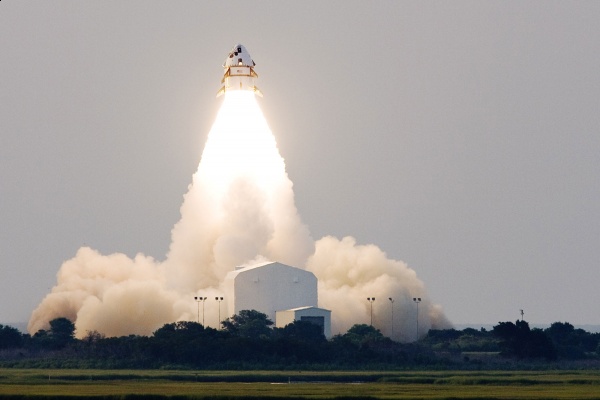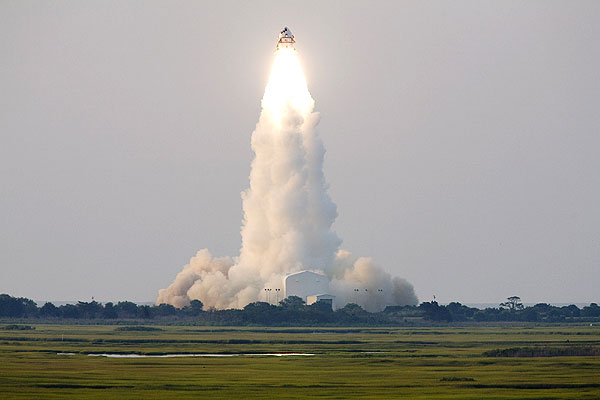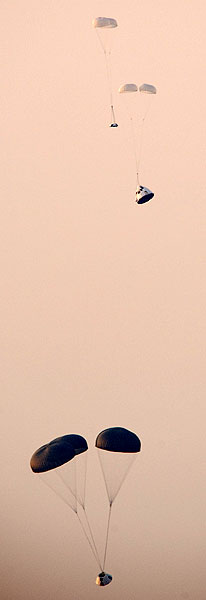
Posted on 07/08/2009 3:44:27 PM PDT by csvset
WALLOPS ISLAND
The escape worked beautifully.
Forty minutes after sunrise Wednesday, a chubby little rocket left the pad at NASA’s facility here, climbing 7,000 feet into the cool morning air.
Less than a minute later, after 16 separate pyrotechnic events, nine parachute deployments and a perfect tailwind, NASA’s newest astronaut escape pod was floating safely down toward the Atlantic off the Eastern Shore.
The unpiloted test was conducted in conjunction with NASA’s Constellation Program, which is designing the Orion spacecraft to take humans to the International Space Station by 2015 and to the moon by 2020.
NASA already has one escape system for the Orion. The rocket tested Wednesday, known as Max Launch Abort System, or MLAS, is an alternate method of quickly and safely removing crews from dangers encountered either at launch or while heading for orbit.
The $36 million project is named for Maxime “Max” Faget, who oversaw helped steer the Gemini, Apollo and Mercury space programs. He also developed the “aerial capsule emergency separation device” – or escape tower – that has become the industry standard.
The Orion’s current escape systemuses a 40-foot open-tower design. The MLAS team – which involved all 10 NASA centers and was headed by the agency’s Engineering and Safety Center in Hampton – sought to develop alternative technology that would accomplish the same goal.
The MLASeliminates the tower by integrating its four motors into the forward fairing, or nosecone. This gives the rocket a cleaner, more aerodynamic shape and, engineers hope, a smoother performance.
So far, so good.
“All aspects, from the first quick look, went well,” said Ralph Roe, the safety center’s director.
Wednesday’s show began just 6:25 a.m., as the 33-foot, 45,000-pound MLAS vehicle pulled away from the pad. At seven seconds, the rocket’s boost skirt and motor cage separated from the crew module, followed by the coast skirt.
At about 20 seconds, twin parachutes shot out to stabilize and reorient the vehicle. Twenty seconds later, the crew module separated from the nosecone, releasing two more parachutes from its forward bay cover to slow its descent.
Almost a minute later, it deployed its four main parachutes to drift gently into the Atlantic.
During the flight, engineers monitored several test points, such as how the vehicle broke apart and how the parachute recovery performed.
“From a project perspective, it was very successful,” Roe said, adding that there was a good, clean separation of the vehicle’s parts.
The test helped confirm the construction team’s goal of a very quick design and build process – just what Faget was known for.
Twenty-one months ago, the MLAS was literally a drawing on a napkin, Roe said. The team spent the next 18 months constructing the system using off-the-shelf components from other programs, then three months testing and tweaking before Wednesday’s launch.
During the Apollo program, NASA employed multiple design teams to work on the more critical rocket components. The Constellation Program doesn’t have the funding to support such an effort, Roe said, so efforts such as the MLAS program help fill the gap by rapidly offering a design that engineers can use to test and glean data.
“The flight test is the fun part,” Roe said. In the coming weeks, the team will pore over data from the more than 185 sensors that monitored the launch. Should the Constellation Program need to tap into aspects of this technology in the future, Roe said, “we’ve done it through the test flight phase.”
The MLAS team includes older Apollo-era engineers who acted as mentors to young engineers with five years experience or less.
It’s these newcomers who may benefit the most from the exercise.
“Hopefully they’ll take us to the moon or beyond,” Roe said.
Matthew Jones, (757) 446-2949, matthew.jones@pilotonline.com


The Max Launch Abort System, an escape system for astronauts, blasts off from Wallops Island, Va., on Wednesday, July 8, 2009. The MLAS will be used with NASA's Orion spacecraft, which is expected to start carrying passengers to the International Space Station by 2015. (Ryan C. Henriksen | The Virginian-Pilot)

There’s a video at the link
very cool
Wish I’d known ahead of time. I am day-tripping distance from Wallops Island.
Space ping
Me too. My new son-in-law is working on this.
I have very severe reservations about Ares-1, and I hope I’m completely wrong.
Best wishes to your daughter, and her husband. He’s doing good work, and even if the Orion spacecraft ends up on another booster, what he’s doing will still be used.
Understood about Aries-1.
Thanks for your best wishes. My daughter is a systems engineer on Orion and is waiting to hear if her astronaut application has been selected.
(please forgive the “proud papa” moment) :-)
Fingers crossed. In 1968, when I was 10, at a time when “good girls” wanted to be nurses, not doctors, and *certainly* not astronauts, I didn’t tell anyone of my dreams.
Good Luck to your daughter, and I hope she doesn’t mind me being jealous.
Disclaimer: Opinions posted on Free Republic are those of the individual posters and do not necessarily represent the opinion of Free Republic or its management. All materials posted herein are protected by copyright law and the exemption for fair use of copyrighted works.